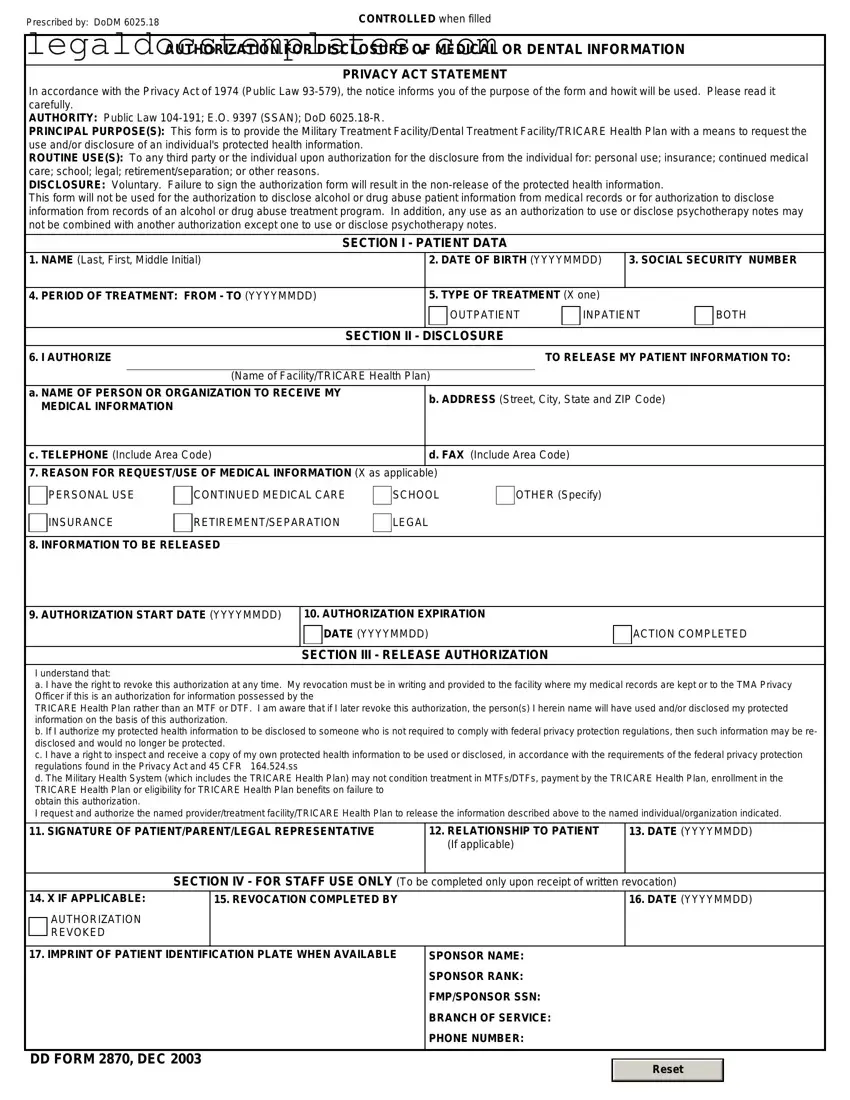The DD 2870 form, also known as the Authorization for Disclosure of Medical or Dental Information, allows military personnel and their families to authorize the release of their medical records. This form is quite similar to the HIPAA Release Form used widely across the civilian healthcare system. The HIPAA Release Form also provides consent for the disclosure of personal health information, ensuring that the process adheres to the Health Insurance Portability and Accountability Act (HIPAA) guidelines. Both forms serve a critical role in protecting patients' privacy while allowing necessary medical information sharing.
Another document similar to the DD 2870 is the General Authorization for Release of Medical Records form often found in civilian hospitals and clinics. This form, like the DD 2870, is used to grant permission to healthcare providers to exchange pertinent medical information with other entities, such as insurance companies or other healthcare providers, to support the patient's treatment, payment activities, or healthcare operations.
The VA Form 10-5345, Request for and Authorization to Release Medical Records or Health Information, shares similarities with the DD 2870. Used by the Department of Veterans Affairs, this form allows veterans to authorize the disclosure of their health information for various purposes. Both forms respect the privacy of the individual's health information while facilitating the sharing of data when authorized by the patient.
The Consent to Release Financial Information form, while not specific to healthcare, shares a conceptual function with the DD 2870. It permits the sharing of an individual’s financial records with authorized parties. Like the DD 2870, which deals with medical or dental records, this form underscores the importance of confidentiality and the need for explicit permission before any personal data is disclosed.
Form SSA-827, Authorization to Disclose Information to the Social Security Administration, is another document that parallels the DD 2870. This form grants the SSA permission to obtain medical, educational, and other information necessary to evaluate a claim for benefits. Both the SSA-827 and the DD 2870 are crucial in ensuring that sensitive information is shared legally and ethically to aid in benefit determination and healthcare.
The Medical Information Release Form (HIPAA), often specific to individual healthcare providers, similarly requires a patient’s consent to release their health information. This form typically caters to the guidelines set forth by HIPAA, emphasizing privacy and the proper handling of medical records, echoing the core purposes of the DD 2870.
The Authorization for Release of Psychological Records is a specialized form specific to mental health services. It allows for the disclosure of sensitive psychological records under the patient's consent. While it’s more specific in scope compared to the DD 2870, both documents ensure that highly confidential information is protected and only released according to the patient’s wishes.
The Educational Records Release Form, used within educational institutions, authorizes the disclosure of a student's academic records. Though its primary focus is not health-related, the consent process mirrors that of the DD 2870, emphasizing individual rights and the controlled sharing of personal information.
Lastly, the Power of Attorney (POA) for Healthcare is a legal document appointing someone to make healthcare decisions on another’s behalf. It intersects with the intent of the DD 2870 insofar as it deals with personal health information, albeit from the standpoint of decision-making authority rather than direct information sharing. Both documents are important in managing health information and ensuring decisions are made in the best interest of the individual.
Each of these documents, while varying in focus and application, shares the common theme of safeguarding personal information. Whether it's health records, financial information, or educational data, the principle of informed consent is central. The DD 2870 and its counterparts are vital tools in managing privacy and consent in a complex information-sharing environment.

